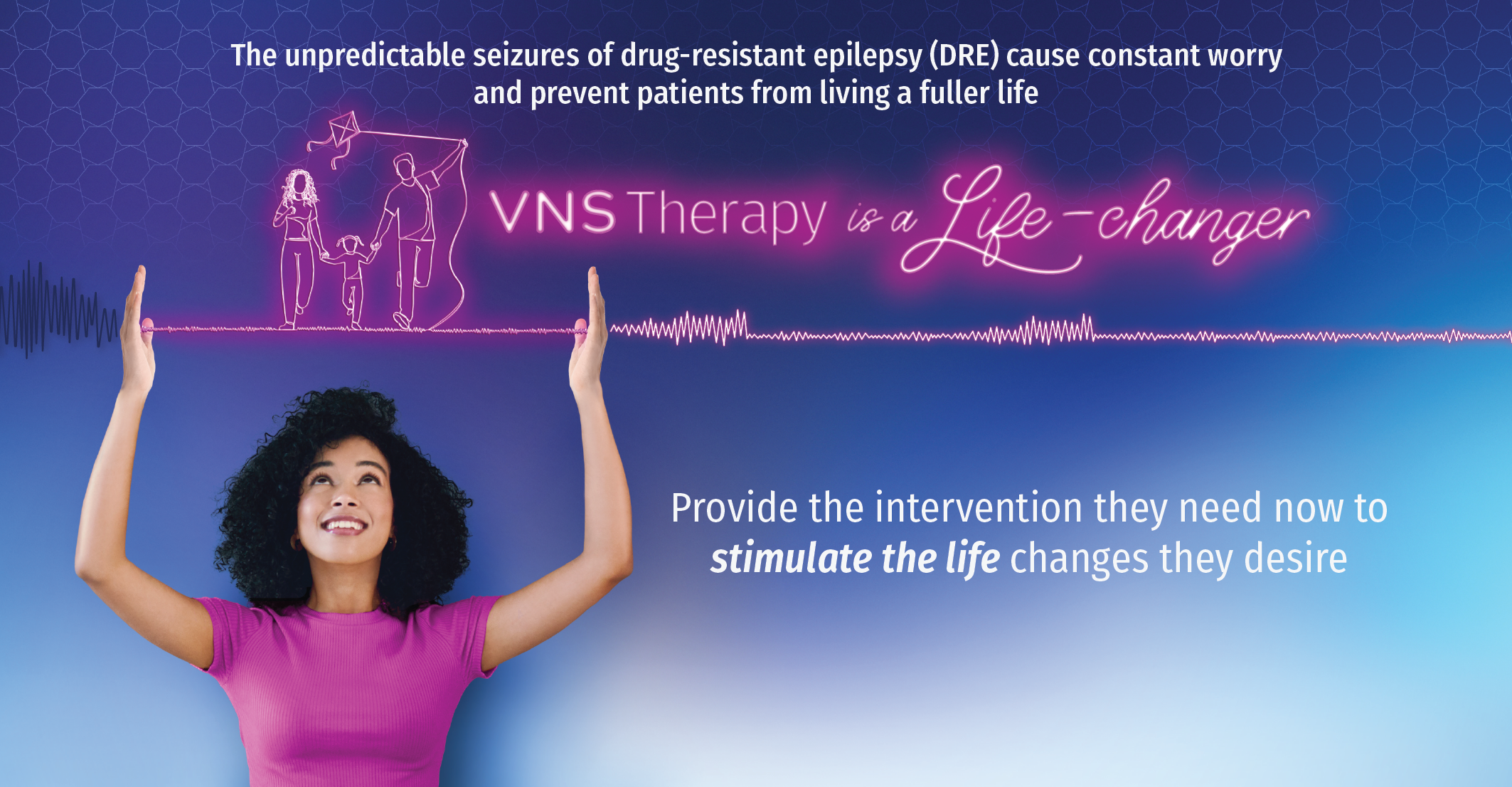
In a survey of 200 VNS TherapyTM patients and caregivers

A stimulating rationale for VNS TherapyTM - break the cycle of repeated anti-seizure medication (ASM) failures
- At least 1/3 of epilepsy patients will not achieve seizure freedom with ASMs2,3
- Patients living with DRE suffer physical, psychological, and societal consequences of refractory seizures along with a heavy drug burden and increased mortality4-7
- Important determinants of health-related quality of life in DRE include the burden of ASM toxicity, depressive symptoms and seizure worry8,9
Stimulating life with VNS TherapyTM - helps improve your patients' emotional well-being and overall quality of life


VNS TherapyTM can reduce mood-related symptoms in patients with DRE. VNS TherapyTM is not indicated for the treatment of depression in epilepsy patients.
K-BDI-II= Korean version of Beck Depression Inventory-II.
The effects of VNS treatment on mood-related symptoms in patients with DRE have varied between studies.
VNS TherapyTM is proven to be a safe adjunctive treatment and is well-tolerated by most patients without contributing to ASM toxicity
- Can improve seizure control without contributing to ASM toxicity
- No drug interactions—can be combined with any ASM regimen
Most common side effects
- The most common side effects of VNS TherapyTM occur during stimulation and generally become less noticeable over time for most patients11,12
- Hoarseness
- Shortness of breath
- Sore throat
- Coughing
- Infection is the most common complication of the procedure13
VNS TherapyTM can help improve their QoL and reduce the burden of DRE
Helps improve your patients' emotional well-being and overall quality of life14
Continued reduction in seizure frequency over time: 76% mean reduction in seizures at 10 years after implant15
Associated with reduced depressive symptoms10
Proven to be a safe, adjunctive treatment and is well-tolerated by most patients without contributing to ASM toxicity13
Can provide improvements in seizure control, with 59% reporting ≥50% reduction and 41% reporting ≥80% reduction16
INTENDED USE / INDICATIONS
Epilepsy (US)-The VNS Therapy System is indicated for use as an adjunctive therapy in reducing the frequency of seizures in patients 4 years of age and older with partial onset seizures that are refractory to antiepileptic medications.
Incidence of adverse events following stimulation (>5%) were voice alteration, increased coughing, hoarseness, shortness of breath, sore throat and nausea. Infection is the most common complication of the procedure.
References: 1. Data on file. Survey Report. LivaNova USA, Inc. Houston, TX. October 2021 2. Chen Z, Brodie MJ, Liew D, Kwan P. Treatment Outcomes in Patients With Newly Diagnosed Epilepsy Treated with Established and New Antiepileptic Drugs. JAMA Neurol. 2018;75(3):279-286. 3. Kwan P & Brodie MJ. Early identification of refractory epilepsy. N Engl J Med 2000; 342: 314-9. 4. Wheless JW. Intractable epilepsy: A survey of patients and caregivers. Epilepsy Behav. 2006;8(4):756-764. 5. Gilliam F. Optimizing health outcomes in active epilepsy. Neurology. 2002;58(8 suppl 5):S9-S20. 6. Fisher RS, et al. The impact of epilepsy from the patient's perspective. Epilepsy Res. 2000;41(1):39-51. 7. Thurman DJ, et al. The burden of premature mortality of epilepsy in high-income countries: A systematic review from the Mortality Task Force of the ILAE. Epilepsia. 2017;58(1):17-26. 8. Luoni C, Bisulli F, Canevini MP, et al. Determinants of quality of life in epilepsy. Epilepsia. 2011;52(12):2181-2191. 9. Loring DW, Meador KJ, Lee GP. Determinants of quality of life in epilepsy. Epilepsy Behav. 2004;5(6):976-980. 10. Kim SJ, Kim DY, Jo HJ, et al. Effect of Long-Term Treatment with Vagus Nerve Stimulation on Mood and Quality of Life in Korean Patients with Drug-Resistant Epilepsy. J Clin Neurol. 2021;17(3):385-392. 11. Ben-Menachem E. Vagus Nerve Stimulation, Side Effects, and Long-Term Safety. J Clin Neurophysiol 2001;18(5):415-418. 12. Morris GL, Mueller WM. Long-term treatment with vagus nerve stimulation in patients with refractory epilepsy. Neurology. 1999;53(8):1737-1735. 13. VNS TherapyTM System Epilepsy Physician's Manual Houston, TX: LivaNova USA Inc.; 2023. 14. Soleman J, Stein M, Knorr C, et al. Improved quality of life and cognition after early vagal nerve stimulator implantation in children. Epilepsy Behav. 2018;88:139-145. 15. Elliott RE, Morsi A, Tanweer O, et al. Efficacy of vagus nerve stimulation over time: Review of 65 consecutive patients with treatment-resistant epilepsy treated with VNS > 10 years. Epilepsy Behav. 2011;20(3):478-483. 16. Hamilton P, Soryal I, Dhahri P, et al. Clinical outcomes of VNS therapy with AspireSR (including cardiac-based seizure detection) at a large complex epilepsy and surgery centre. Seizure. 2018;58:120-126. 17. Data on file. E36 E37 Pooled Calculations. LivaNova USA, Inc. Houston, TX. 2015.
